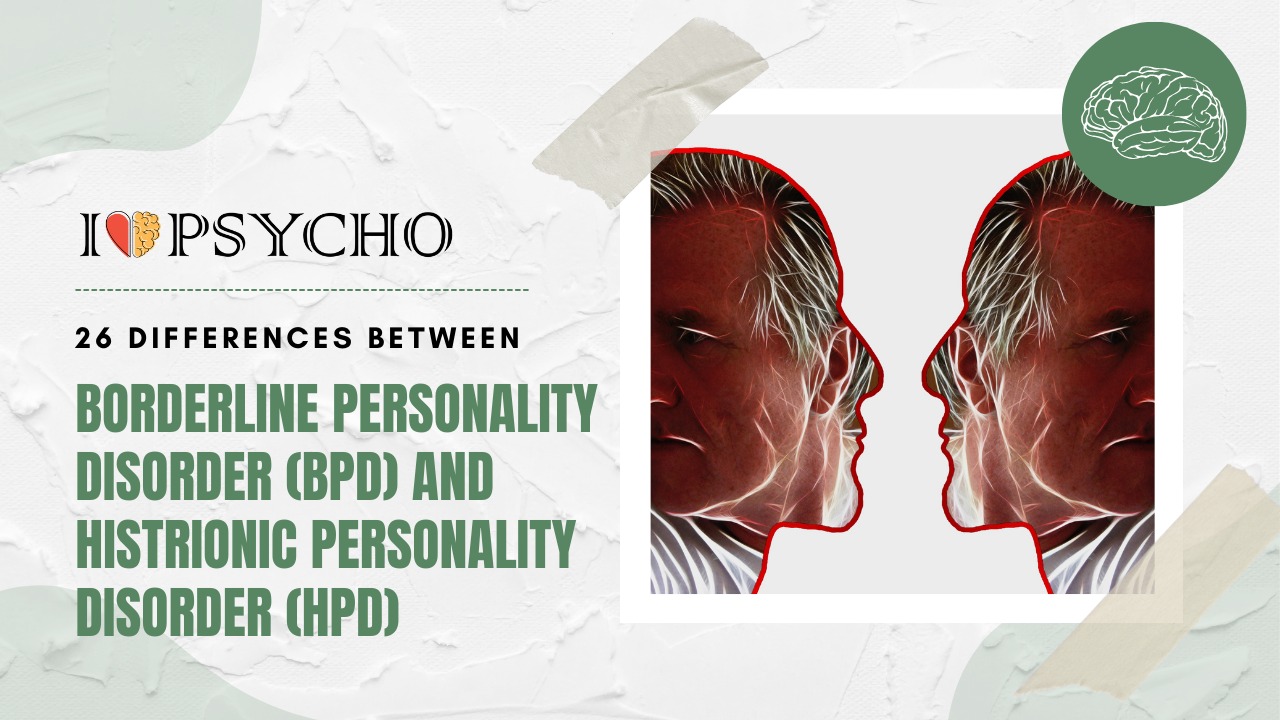BPD and HPD are two separate but sometimes misinterpreted mental health illnesses with different basic traits, emotional expressions, and behavioral patterns. BPD is characterized by unstable self-image, acute abandonment dread, emotional instability, and relational issues. Impulsive behavior, self-harm, and intense emotional reactions are common in BPD patients due to fast mood, self-worth, and identity changes. On the other hand, HPD involves constant attention and affirmation. HPD patients have heightened emotions, and a strong craving for praise, and may engage in attractive or provocative behavior.
These behaviors are not caused by unstable self-identity or abandonment dread like BPD. Another distinction is interpersonal interactions. Due to rejection dread and powerful emotional reactivity, BPD sufferers have trouble sustaining stable relationships. Their push-pull relationship seeks intimacy yet fears desertion, causing tension. However, persons with HPD build connections more quickly but may struggle to keep them owing to their attention-seeking and little emotional depth.
Emotional dysregulation causes strong mood swings and difficulty controlling emotions in BPD. Extreme anger, despair, and anxiety can escalate quickly in these people. HPD patients exhibit their emotions powerfully but without the emotional instability of BPD patients. Self-harm and suicidal inclinations are more frequent in BPD than in HPD. BPD sufferers may self-harm to deal with overwhelming emotions or achieve control. Such behaviors are rare in HPD.
BPD and HPD are complicated illnesses with overlapping features, making diagnosis difficult. HPD features may change as people age, unlike BPD, which frequently develops in early adulthood and is more stable. In conclusion, BPD and HPD share attention-seeking behaviors but differ in emotional dynamics and behavioral patterns. However, HPD emphasizes attention, excessive emotions, and appreciation above abandonment and self-identity. various differences are essential for correct diagnosis and customized therapy for various illnesses.
Also Read: 44 Difference between Dissociative Identity Disorder (DID) and Dissociative Amnesia
26 differences between Borderline Personality Disorder (BPD) and Histrionic Personality Disorder (HPD):
|
S.No. |
Aspects |
Borderline Personality Disorder (BPD) |
Histrionic Personality Disorder (HPD) |
|
1 |
Core features |
Emotional dysregulation, unstable relationships, self-image, impulsivity |
Excessive attention-seeking, emotional expression, seductive behavior |
|
2 |
Emotional instability |
Intense and rapid mood swings |
Emotions are generally shallow and exaggerated |
|
3 |
Self-image |
Unstable self-identity and self-worth |
Exaggerated self-image, easily influenced by others |
|
4 |
Impulsivity |
Frequent impulsive behaviors (e.g., self-harm, substance abuse) |
Impulsivity primarily focused on seeking attention |
|
5 |
Fear of abandonment |
Intense fear of real or perceived abandonment |
Fear of being alone or not being the center of attention |
|
6 |
Relationships |
Intense, unstable, and stormy relationships |
Superficial and easily formed relationships |
|
7 |
Identity disturbance |
Frequent changes in values, goals, career, or sexual identity |
Identity shaped by the desire to please others |
|
8 |
Manipulative behavior |
Tends to manipulate to avoid abandonment or regulate emotions |
Manipulates to gain attention or admiration |
|
9 |
Self-harm behaviors |
Common, as a way to cope with emotional pain |
Less common, but may occur for dramatic effect |
|
10 |
Splitting |
Frequently engages in black-and-white thinking, idealization, and devaluation |
Less likely to engage in splitting |
|
11 |
Paranoia |
May experience paranoid thoughts, especially in response to perceived abandonment |
Less likely to experience paranoia |
|
12 |
Suicidal behaviors |
High risk of self-harm and suicide attempts |
May threaten suicide for attention, but attempts are less common |
|
13 |
Sense of emptiness |
Often experiences chronic feelings of emptiness |
Less likely to report chronic emptiness |
|
14 |
Dissociation |
May experience dissociative episodes during stress |
Less likely to experience dissociation |
|
15 |
Treatment approach |
Dialectical Behavior Therapy (DBT) is a common treatment |
Cognitive-Behavioral Therapy (CBT) and psychodynamic therapy are often used |
|
16 |
Emotional regulation |
Difficulty regulating emotions, leading to intense emotional reactions |
Exaggerated emotional expression but better emotional regulation |
|
17 |
Self-harming motives |
Self-harm is often a response to emotional pain or emptiness |
Self-harm may be a bid for attention or drama |
|
18 |
Identity crisis triggers |
Often triggered by unstable relationships or perceived rejection |
May have identity crises when not the center of attention |
|
19 |
Manipulative style |
Manipulates to avoid real or perceived abandonment |
Manipulates to maintain attention or admiration |
|
20 |
Attention-seeking |
Seeks attention but may push others away due to intense emotions |
Actively seeks attention and approval from others |
|
21 |
Impression management |
Less concerned with impression management, focuses on emotional stability |
Concerned with maintaining a positive image in the eyes of others |
|
22 |
Relationship dynamics |
Prone to intense, often tumultuous relationships |
Relationships may be superficial but less stormy |
|
23 |
Co-morbid conditions |
Commonly co-occurs with mood disorders, substance abuse |
May have comorbid mood disorders or somatic symptom disorders |
|
24 |
Self-esteem |
Often low and tied to perceptions of abandonment |
Fluctuates but tends to be more dependent on external validation |
|
25 |
Communication style |
Often communicates intense emotions and pain |
Communicates in a dramatic, emotionally charged manner |
|
26 |
Relationship longevity |
Relationships may be tumultuous, leading to frequent breakups |
Relationships may be shorter-lived due to shifting interests |
Also Read: Counseling Psychology: What You Need to Know
Frequently Asked Questions (FAQS)
Q.1 What is BPD and how does it differ from HPD?
Mental disease BPD produces unstable self-identity, fear of abandonment, emotional dysregulation, and relationship troubles. BPD patients often self-harm, and exhibit mood swings, and impulsivity. High emotions, attention-seeking, and validation characterize Histrionic Personality Disorder (HPD). Both diseases crave attention, but BPD emphasizes identity instability and rejection, whereas HPD emphasizes admiration.
Q.2 What obstacles do BPD and HPD patients face in relationships?
Due to their fear of abandonment and powerful emotions, BPD sufferers have trouble establishing relationships. They may crave intimacy yet fear rejection in relationships, causing friction and instability. However, HPD persons build connections more quickly but may struggle to keep them owing to their attention-seeking and little emotional depth.
Q.3 Do BPD and HPD share traits?
BPD and HPD share attention-seeking behaviors. Both diseases may include intense feelings and affirmation. But the reasons and emotions are very different. BPD is characterized by emotional instability, self-identity issues, and abandonment dread, whereas HPD is characterized by constant attention and appreciation.
q.4 Which is more linked to self-harm and suicide: BPD or HPD?
Borderline Personality Disorder (BPD) is more likely than Histrionic Personality Disorder (HPD) to cause self-harm and suicide. BPD sufferers may self-harm to deal with overwhelming emotions or recover control. HPD does not cause self-harm, although persons with it may use various attention-seeking behaviors to manage their feelings.
Q.5 Are BPD and HPD treatable?
Although the methods differ, BPD and HPD may be treated. Dialectical behavior therapy (DBT) helps BPD patients control emotions, strengthen relationships, and learn coping skills. CBT may help HPD by addressing attention-seeking and facilitating better emotional expression. For appropriate diagnosis and personalized therapy, some illnesses require expert guidance.









